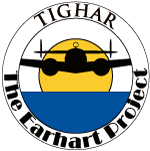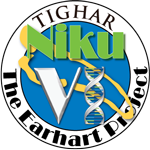|
2010: Niku VI
Expedition

Updates |
|
To avoid
lengthy download times, the updates are divided into seven
day periods. This is the second week of the expedition. Date links refer
to U.S. days; Nikumaroro is on the other side of the date line, so it’s
tomorrow there.
|
| Reports
are in reverse date order so that those who check every day don't have to
scroll down endlessly as the expedition progresses. |
|
If
you are new to this page, just click on the earliest date to the left (down
at the bottom of the list) and then scroll up to read each posting in order. For previous weeks, click on the “Week” links above. |
| Dateline: Nikumaroro, 0520 Local Time, 6 June 2010. |
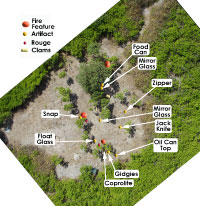 This team is working so well, and so efficiently, that Tom King decided to re-open a few of the features excavated during Niku V to see if more could be found. The answer was a definite yes. In the SL feature they found two more pieces of rouge – small, roughly square. The also got a start on re-opening the WR unit, where the bottles were found, and immediately found another piece of green glass. Work will continue on that unit today. To see where these items were found, click on the little map to the right and a new window will open with a larger version. This is a KAP photo from 2007 with some of the main features plotted in. This team is working so well, and so efficiently, that Tom King decided to re-open a few of the features excavated during Niku V to see if more could be found. The answer was a definite yes. In the SL feature they found two more pieces of rouge – small, roughly square. The also got a start on re-opening the WR unit, where the bottles were found, and immediately found another piece of green glass. Work will continue on that unit today. To see where these items were found, click on the little map to the right and a new window will open with a larger version. This is a KAP photo from 2007 with some of the main features plotted in.
Megan found a strange little artifact, plastic (Lucite?), rather like three teeth from a comb, but the teeth weren’t quite right for a regular comb, heavier and with some kind of reinforcing ridge. A woman’s hair clip or old fashioned comb for keeping hair in place? This will be an interesting one to look into.
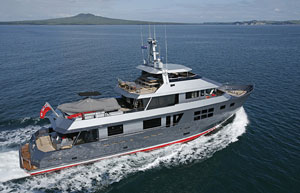 The work is going quickly, so much so that they will be able to expand the area and do more than originally planned, especially with the extra hands arriving today. When I talked to Ric, dawn was just breaking, and he was going to go up to the bridge and see if there was any sign of VvS1 on the radar or horizon. The new arrivals are Graham, Art, Janis, Dan, another cameraman, and the observer from PIPA. It is hoped that the ROV work can shift to VvS1 which has bow thrusters and will be a more stable platform, so that current, seas, and wind will not be as much of a factor while they deploy the ROV on the long cable. (That’s VvS1 at left.) The work is going quickly, so much so that they will be able to expand the area and do more than originally planned, especially with the extra hands arriving today. When I talked to Ric, dawn was just breaking, and he was going to go up to the bridge and see if there was any sign of VvS1 on the radar or horizon. The new arrivals are Graham, Art, Janis, Dan, another cameraman, and the observer from PIPA. It is hoped that the ROV work can shift to VvS1 which has bow thrusters and will be a more stable platform, so that current, seas, and wind will not be as much of a factor while they deploy the ROV on the long cable. (That’s VvS1 at left.)
There was an adventure yesterday. Keep in mind that Adventure is what happens when things go wrong, and wrong they did go. The whole gang, 18 people, were in the skiff on the way from Nai’a to the landing channel when the outboard started making odd noises, knocking and banging, and then quit. They were dead in the water, drifting toward the reef edge with big rollers taking them closer to catastrophe by the minute. After what seemed like hours, but was probably more like 10 minutes, the crew was able to coax the engine into starting and running at idle, giving them just enough steerage-way to get into the channel. Half way up the channel it quit for good; the bearing welded itself to the prop shaft turning the engine into an anchor. But they got in on a wing and a prayer, Nai’a came ’round and close in, they got the skiff back to Nai’a by paddling, and a replacement engine was fitted and tested. Not a good feeling, though, to be heaved ever closer and closer to that reef, with the bones of Norwich City to remind you of the consequences of sudden impact!
|
| Dateline: Nikumaroro, 0525 Local Time, 5 June 2010. |
Yesterday the group working on the fire feature where the rest of the knife was found also found another major part of the glass jar. They now have the entire mouth of the jar, and can connect the three pieces found together to reconstruct the shape and size completely. The puzzling thing is that this piece was 30 meters away from the other pieces. Was there some sort of residue in the jar that was attractive enough to a crab to make him drag it away? Or was the jar broken deliberately to obtain a sharp piece of glass as a tool? The edges are still sharp enough that they have to be careful the plastic bag doesn’t split around it.
Karl has observed that the glass we have found at the Seven Site, in 2007 and this trip, is all castaway glass. There are no Coke bottles, and only one beer bottle. It is those bottles that would show a major presence by the Coasties. Without that evidence we have to conclude that the Coast Guard visits may have been confined to one target practice day, rather than repeat visits.
Another question: Why so many fires? Yes, there is a ring of fire around the ren tree, but there are also other fire features scattered about, each with its collection of bird, fish, and/or turtle bones. Why not have one fire location? Did the crabs invade each campfire in search of scraps?
Curtis and Lonnie got wonderful KAP (Kite Aerial Photography) yesterday. Ric will be working today on logging in artifact locations on some shots.
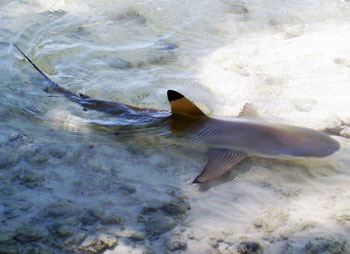 The AUV finished mapping the lagoon with sonar, and both yesterday and today they are diving on things that look like promising targets. Visibility is just about zero, so they are working by feel, and hoping they’re not feeling up a shark. So far all the targets have turned out to be coral heads. The AUV finished mapping the lagoon with sonar, and both yesterday and today they are diving on things that look like promising targets. Visibility is just about zero, so they are working by feel, and hoping they’re not feeling up a shark. So far all the targets have turned out to be coral heads.
Our Customs observer on this trip is Takirua Taabu (he was on the 2007 trip too). Yesterday was his birthday, and Suli found out through some sort of devious chat. She surprised him with a cake and candles, and everyone sang Happy Birthday – a nice touch of home!
Tomorrow the second boat arrives early in the morning. There will be a brief familiarization tour of the village and Seven Site, then right to work; there is still a lot to do.
A black tip reef shark in the shallows, constant companions for work in the lagoon.
|
| Dateline: Nikumaroro, 0530 Local Time, 4 June 2010. |
No exciting news today, alas! But that’s the way things go in the field. The hours of slogging to hours of excitement ratio is usually pretty poor.
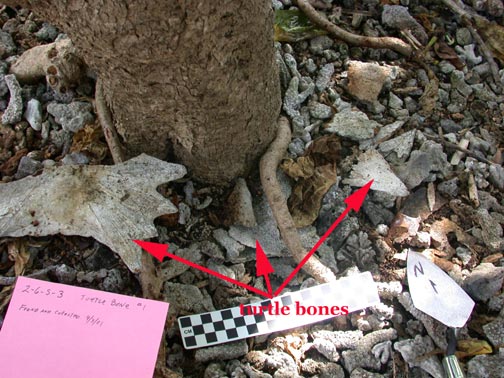 The new fire feature yielded a lot of turtle bone, perhaps as much as a quarter of a turtle – carapace, bones, and so on. There are some fish bones as well, a couple of them quite large. Again, this tells us that the use of this site was pretty intensive and long-lasting. (The photo at right is from Niku IIII in 2001.) The new fire feature yielded a lot of turtle bone, perhaps as much as a quarter of a turtle – carapace, bones, and so on. There are some fish bones as well, a couple of them quite large. Again, this tells us that the use of this site was pretty intensive and long-lasting. (The photo at right is from Niku IIII in 2001.)
The AUV and side scan sonar survey of the lagoon is about 80% done. Walt and John stayed up late looking at sonar read-outs and planning today’s work, which will be diving on the most interesting targets. The examination of the targets will probably be done mostly by touch as the lagoon water is very murky.
When the day’s work is less exciting, the group compensates by laughing and joking even more in the evening. Ric says everyone is doing a great job, keeping spirits high and the work going strong in spite of the heat and the disappointments. Interestingly, everyone is reporting having very vivid, crazy, brightly-colored dreams. Is Nei Manganibuka (the spirit of the island) sending them messages?
|
| Dateline: Nikumaroro, 0530 Local Time, 3 June 2010. |
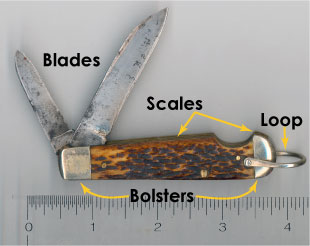 The team found more new things yesterday. First, another piece of the knife, which brings the inventory to three out of four bolsters and all three scales. Having studied what we have so far, they think that the knife was broken open for the explicit purpose of removing the two blades. To make a fishing spear? to get at strong parts for prying open clams? We don’t know, of course. Interestingly, in the process of digging out the piece found yesterday they discovered they were on the edge of yet another fire feature. Today they will excavate that in an orderly fashion and see what else might be lurking in the charcoal. The team found more new things yesterday. First, another piece of the knife, which brings the inventory to three out of four bolsters and all three scales. Having studied what we have so far, they think that the knife was broken open for the explicit purpose of removing the two blades. To make a fishing spear? to get at strong parts for prying open clams? We don’t know, of course. Interestingly, in the process of digging out the piece found yesterday they discovered they were on the edge of yet another fire feature. Today they will excavate that in an orderly fashion and see what else might be lurking in the charcoal.
 Another thing was found, and right now they are thinking that it may be part of a vacuum tube used for target practice by the Coasties. They’re calling it the “dragonfly.” I have sketched it based on Ric’s description, which is a risky thing to do, but I did it anyway. In total it measures about one inch by one inch, and is made of brass or copper. The center portion is a rod, too thick to be called a wire. It has serrations on one side – not threads, but regular indentations. The “wings” are flat and thin, with holes as shown. An interesting piece. Another thing was found, and right now they are thinking that it may be part of a vacuum tube used for target practice by the Coasties. They’re calling it the “dragonfly.” I have sketched it based on Ric’s description, which is a risky thing to do, but I did it anyway. In total it measures about one inch by one inch, and is made of brass or copper. The center portion is a rod, too thick to be called a wire. It has serrations on one side – not threads, but regular indentations. The “wings” are flat and thin, with holes as shown. An interesting piece.
They tried doing a rubbing on the glass jar to pull up the letters or numbers, but were unsuccessful, so that will have to wait upon getting home and into a controlled lab environment.
 One challenge in working around the Seven Site this trip is that the giant centipedes are more numerous than they used to be. And they are extremely fast. One ran up Gary’s back yesterday while he was excavating and was flipped off just before it got to his head. They leave a nasty blister and burn, so people are not lying around on the ground to rest. Some are eight to ten inches long. (The picture at right is just an example, not a photo of one of Nikumaroro’s centipede.) One challenge in working around the Seven Site this trip is that the giant centipedes are more numerous than they used to be. And they are extremely fast. One ran up Gary’s back yesterday while he was excavating and was flipped off just before it got to his head. They leave a nasty blister and burn, so people are not lying around on the ground to rest. Some are eight to ten inches long. (The picture at right is just an example, not a photo of one of Nikumaroro’s centipede.)
The underwater group got a big section of the lagoon done yesterday with the AUV and the towed sonar. Today and tomorrow they’ll finish up the sonar work and then begin diving on targets.
|
| Dateline: Nikumaroro, 0540 Local Time, 2 June 2010. |
 An exciting day at the Seven Site yesterday. During Niku V (2007) a piece of a pocketknife was found at the site. The piece found is known as the “side scale” – a pocket knife of this type has two side scales and a center scale, and also has “bolsters” (the end cap) on both ends. Ordinarily the covering of bone or plastic would be attached to the side scales, and the center scale would separate the two blades. An exciting day at the Seven Site yesterday. During Niku V (2007) a piece of a pocketknife was found at the site. The piece found is known as the “side scale” – a pocket knife of this type has two side scales and a center scale, and also has “bolsters” (the end cap) on both ends. Ordinarily the covering of bone or plastic would be attached to the side scales, and the center scale would separate the two blades.
Ric was metal detecting at the extreme south edge of the site and found the rest of the broken side scale; the center scale; and the other side scale. The loop end bolsters are gone, but the other end bolsters are there. No blades, though. He speculates that both blades got snapped off in use, so the possessor of the knife pounded it apart to get at the scales, they still being useful for prying at things like clams.
Meanwhile, Megan found the top of a broken glass jar, and Karl found a side and part of the bottom. It’s a small jar, clear glass, with rounded interior on the bottom rather than 90° angles. It is 3 inches high, and the mouth diameter is 1.75 inches. Ric describes it as “elegant.” It has some sort of pattern on the outside sides, and some sort of embossing on the base, letters or numbers. They cannot read the embossing (too dirty) but are going to try to get a rubbing through the plastic bag it is in this evening (artifacts are not handled or cleaned as a matter of routine until it can be done in a really controlled setting). This is very likely another gender-specific item, perhaps a cosmetic jar.
Ric also found a small clip, brass or copper, with a complex shape. It would screw onto a flat surface and hold a cylindrical object. It has numbers on it: 336 or 346, and beneath that 260. No letters. They are going with the idea of this being related to Coast Guard activity, but it was still collected and will be investigated fully.
The pig bones experiment was carried out and the bones did indeed “disappear” into the coral rubble; in fact, Ric had trouble finding them again.
Today, they will clear additional area to the south (all archeological finds are made just outside of the defined search area, usually at the junction of two or more maps of different scale) and continue to work the lanes in that direction and find more Good Stuff.
The ROV is finished with the work they can do until the long cable arrives at the end of the week, so that team will finish the side-scan sonar of the lagoon.
|
| Dateline: Nikumaroro, 0530 Local Time, 1 June 2010. |
There was no excavation at the Seven Site yesterday as it was a rest day. As usual on rest days, everyone went ashore and did something strenuous, mostly walking long stretches of beach to see the Coast Guard site, the Norwich City wreck, and other points of interest on the island.
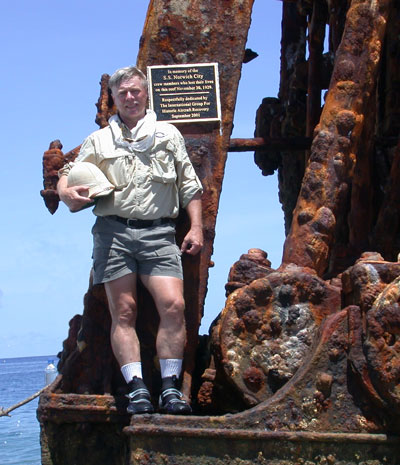 Jesse, on his only day ashore so far, went out to the Norwich City. The memorial plaque we installed in 2001 had come off, which says quite a lot about the violence windward weather can wreak on the island: the plaque is bronze, weighs approximately 30 pounds, and was affixed to the steel structure of the engine with industrial epoxy. Jesse found it well up on the reef in the debris of the ship, and recovered it. There is a tiny museum in England which will give it a good home. The engine itself is within one more good blow of collapsing entirely. Soon there will be no visible sign of the once-imposing wreck. Jesse, on his only day ashore so far, went out to the Norwich City. The memorial plaque we installed in 2001 had come off, which says quite a lot about the violence windward weather can wreak on the island: the plaque is bronze, weighs approximately 30 pounds, and was affixed to the steel structure of the engine with industrial epoxy. Jesse found it well up on the reef in the debris of the ship, and recovered it. There is a tiny museum in England which will give it a good home. The engine itself is within one more good blow of collapsing entirely. Soon there will be no visible sign of the once-imposing wreck.
Some general observations about work at the Seven Site: the atmosphere is one of serious concentration, with little chatter. The steady “clink clink clink” of trowels on coral rubble is almost the only sound. (Ric says it reminds him of the opening scene in Spartacus.) Every now and then someone will sit back and call for Tom or Andrew to come and look at something. (Andrew grew up accompanying his father on dinosaur digs in the Gobi Desert and can spot a bone at 50 paces.) Otherwise, each person sticks to the assigned lane, stretching occasionally but with eyes still on the ground.
When clearing, they find they are using the chain saws more than the loppers this trip. It’s very dangerous, and only one saw is operated at a time. Only Bill and Karl use saws, with Ric and sometimes a member or two of the crew to clear debris. The injury most feared is one involving massive loss of blood. With definitive medical care easily 36 hours away, there isn’t a lot of room for carelessness or complacence.
One little experiment they will run tomorrow is to take the pig bones recovered from the taphonomy experiment to the Seven Site, drop them on the coral rubble, and film the ensuing search. “Watch the bones disappear! Can you find them?”
|
| Dateline: Nikumaroro,
0530 Local Time, 31 May 2010. |
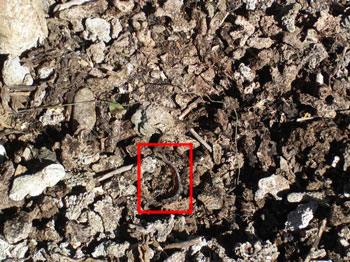 |
| This photo from 2007 shows how difficult it can be to spot artifacts in a fire feature covered with brown duff and coral rubble. See the brown glass bottle bottom? Photo by Tom Roberts. |
A very straightforward day yesterday, with operations continuing at the Seven Site in an orderly fashion. Ric found yet another fire feature, with some metal stuff in it. They don’t know what the metal stuff is yet, or what it might be, but it’s there. There is some speculation that all of these fire features may show a “Clean cup move down” point of view on the part of our castaway, with a different fire for every meal. Not surprising if there are dozens, even hundreds of crabs crawling over the remains of your last meal!
This new feature is on the ocean (east) side of the Seven Site. Boundaries have now been fixed to the north, south, and west; the eastern edge is still unknown but (again, speculation) the castaway’s camp does seem to be confined fairly closely to the original Seven Site delineated in 2007. What they are finding is that the use was more intensive than original thought, perhaps indicating that the castaway was there for quite a while.
Today they will stand down from formal operations. Those who wish to will go ashore on jaunts of their own, others will stay aboard and rest, catch up on notes, and the like. The ROV may work if seas and currents permit.
|
|
|
|
|

